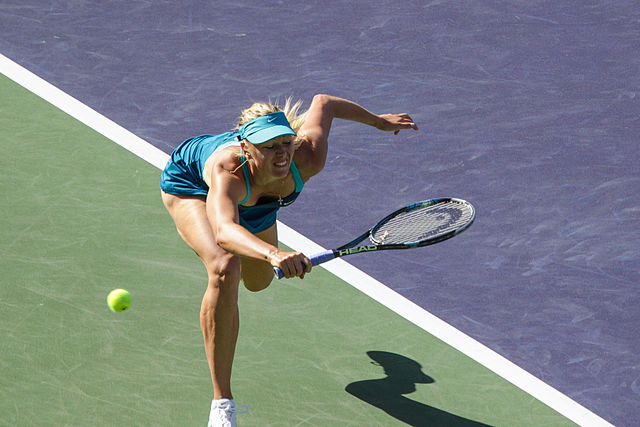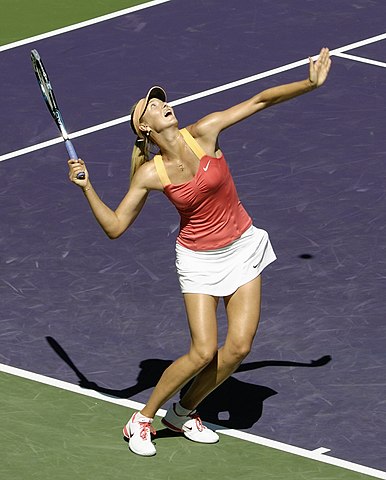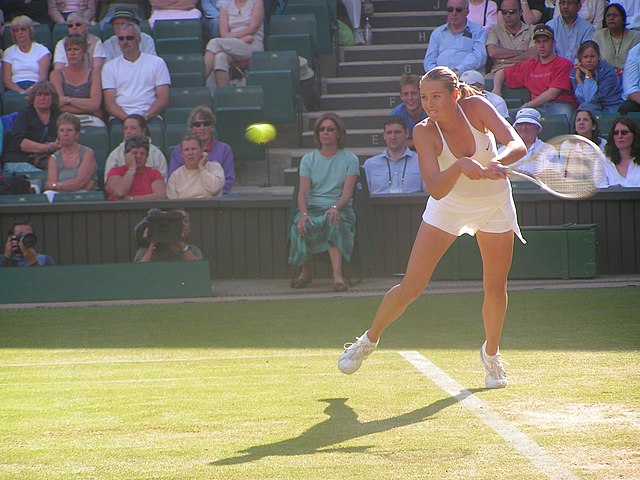
Credit: Mike McCune
In 2022, I’m counting down the 128 best players of the last century. With luck, we’ll get to #1 in December. Enjoy!
* * *
Maria Sharapova [RUS]Born: 19 April 1987
Career: 2003-19
Plays: Right-handed (two-handed backhand)
Peak rank: 1 (2005)
Peak Elo rating: 2,327 (2nd place, 2008; she ranked 1st in 2009 with a lower rating)
Major singles titles: 5
Total singles titles: 36
* * *
For me, it all comes down to the left-handed forehand. Maria Sharapova played right-handed, of course, but she was a natural lefty. When she chased down a ball and didn’t have time to smack a two-handed backhand, out went the left hand for an improvised, last-ditch effort.
Sharapova probably hit more wrong-handed shots than any all-time great who wasn’t actually ambidextrous. Usually, her lefty stabs were hail marys, desperate attempts to reset the point. But they weren’t only that. She hit left-handed passing shots, left-handed volleys, even a few lefty overheads. She hit them–and won points!–against Henin, Halep, Hantuchová, and the occasional opponent whose name didn’t start with H.
They did not look good. While you can find plenty of unlikely highlights on Youtube, her percentage chance of winning a point once she took her right hand off the racket must have been in the single digits. Probably not high single digits. When a lefty shot succeeded, it was often because her opponent got distracted by the crowd’s reaction and missed an easy putaway.
Point is, Sharapova owes no part of her fame, fortune, or substantial trophy haul to her left-handed arsenal.
Still, it’s impossible to imagine her giving up on the balls she couldn’t reach with the double-hander. Most of the world came to know her as a photogenic blonde, a millionaire spokeswoman for luxury products, a teen queen who inspired one misplaced Anna Kournikova comparison after another. But Maria was a competitor first, a competitor second, and a competitor third. Everything else came after that.
Sharapova didn’t win because of the left-handed forehand. But they didn’t call her the Iron Maiden for nothing. Her steely resolve was unshakeable, from her first full season at age 16 through her injury-riddled later years on tour. The commitment to chasing down the most hopeless balls was inseparable from the bludgeoning strokes and pure grit that more directly fueled the Russian’s long run at the top of the game.
* * *
It wouldn’t have taken much for Sharapova to end up as a left-handed tennis player. As an eleven-year-old at Nick Bollettieri’s academy, she and father Yuri sought out Rick Macci, another coach known for shepherding promising youngsters to the pros.
Macci found Maria’s forehand in a dire state. It was cramped and awkward; she could barely keep a rally going off that wing. Her backhand, supported by her dominant left hand, was a vastly superior shot–“already timed and synchronized,” as the coach put it.
Then he saw her hit a left-handed forehand. It was “one of the best I’ve ever seen. Knife through butter, smooth as silk.” For a promising junior to change dominant hands at age eleven was unheard of, but Yuri was willing to take the plunge. He recognized that junior results were meaningless. He wanted Maria to be great at 18, not 12. If the right-handed forehand was going to hold her back, now was the time to fix it.
The Sharapovas prepared to move to Macci’s academy and develop a left-handed game. But IMG, the management company that bankrolled Maria’s training at Bollettieri, used a combinations of lures (more resources!) and threats (no wild cards!) to keep her. As a lefty, Maria’s backhand wouldn’t be as strong, so Bollettieri kept her playing from the right side. IMG hired groundstroke technician Robert Lansdorp to repair her forehand.
Ultimately, it didn’t matter much which side Sharapova landed on. Her forehand was never flawless, but it was effective. Her smoother backhand won her points, as well. While she might have gotten more mileage out of a left-handed serve–just imagine Sharapova’s ground game combined with, say, the serve of Petra Kvitová–her right-handed deliveries were plenty powerful.
Strange as it is to say, the specifics of Maria’s stroke equipment always took second place to her perseverance. “Her mind was just unbelievable,” said Bollettieri. “It was never in her mind to be a failure.”
* * *
Sharapova didn’t have much time to contemplate anything other than superstardom. She made a surprise run to the Wimbledon fourth round at age 16, in 2003. A year later, she won the whole thing.
It wasn’t just the victory. It was the way she won. Maria beat fifth-seed Lindsay Davenport in the semi-finals, bouncing back from a lost first set and wrenching the momentum away from the American in a second-set tiebreak. How bold was she? Of the seven points she won in that tiebreak, she hit winners on six of them. “I had control of the match,” said Davenport, “and she took it from me.”
Two-time defending champion Serena Williams never got close to a tiebreak. Sharapova beat her in the final, 6-1, 6-4, such a convincing defeat that it felt like a changing of the guard. S.L. Price wrote in Sports Illustrated:
Over 73 minutes Sharapova stripped away Williams’s armor, the hauteur that has marked her in her prime, and the resulting sights and sounds were almost unimaginable: Williams slipping at the key moment of an epic rally and bouncing on her rear end; Williams, too startled to handle a laserlike Sharapova return, emitting a loud moan…. Then there was Williams, never before at a loss for answers, meeting the press after the match and saying, “I just didn’t… I don’t know what happened.”
Serena gave the new champion the highest praise of the day: “She’s kind of like me: She doesn’t back off.” Martina Hingis called her “fearless.”
To the coaches and agents who had watched her grow up, Sharapova might have matured ahead of schedule, but the title was no surprise. They had known they had a future champion on their hands the moment they saw her. Now came the rewards: Celebrity, endorsements, and an apparently clear path to number one.
* * *
In some ways, Sharapova fulfilled all of her early promise and then some. She finished 2004 with a victory at the year-end WTA Tour Championships, beating an injured Serena Williams for the title. She didn’t reach another major final in 2005, but her cumulative effort–three semis and one quarter at the slams–combined with three smaller tournament wins to give her the number one ranking in August.
Sponsors were delighted to learn that Maria’s Slavic good looks came paired with flawless English and preternatural poise. They made her a multi-millionaire before she won her second major. Ahead of the 2006 US Open, she starred in a Nike ad campaign that managed to both trade on her appearance and capture her competitive fire in just 60 seconds.
By breathing new life into the women’s game, though, Sharapova woke up the sleeping giant that was Serena. The two women played a rematch of the Wimbledon final at the 2005 Australian Open. The Russian won the first set and served for the match at 5-4 in the second. She sent two serves into the net on break point and Williams seized the set. In the decider, Sharapova broke in the seventh game and served for it again. This time she squandered three match points and missed another three chances to break the Serena serve at 6-all. The American took the match, 2-6, 7-5, 8-6.
The head-to-head now stood at two matches apiece. No one would’ve predicted it in January 2005, but in 18 more meetings–including three slam finals and an Olympic gold medal match–Maria would never win another.
In Williams, Sharapova met her equal, and more. Maria hit hard; Serena hit harder. The Russian served big; the American possessed the biggest first-strike weapon in the game. Everyone raved about Sharapova’s determination, but when Williams’s mind was on tennis, her own will to win was breathtaking. Put her under enough pressure, and Serena would even hit her own awkward left-handed forehand.
Fortunately for Maria, her nemesis left a few titles for the rest of the field.
At the 2006 US Open, Sharapova returned to the grand slam winner’s circle. She did it so conclusively that it was a wonder her second major was so long in coming. In seven matches, the field took only one set against her, and that came in a semi-final against Amélie Mauresmo. Maria won that match, 6-0, 4-6, 6-0. She was just as imperious in the final, defeating Justine Henin, 6-4, 6-4.
* * *
The Russian was only 19, but a few things were already clear. First, she’d never be the most popular player in the locker room. She was haughty, and as charming as she could be with sponsors, she didn’t seem to care about having friends on tour.
Second, she wasn’t about to stop grunting. No magazine feature was complete without an attempted transcription (was it EEEEEHHHHH UHHHhhhh!!!! or RHHEEE-AAAHHHH!?) and reporters occasionally stirred the pot by collecting catty remarks from other players. Sharapova’s response was always the same. She just told people to watch the match.
Third, the Kournikova comparisons would linger, no matter how nonsensical. Sure, Maria won about as many sets from Serena as Anna K would have. And yes, her endorsement income far surpassed anything her on-court performance seemed to merit. But a full decade into her pro career, she still faced questions about her priorities. “It’s not a show for me,” she said in 2012, apparently to a reporter who had never seen her battle through a three-setter. “It’s my career. And I take it very seriously.”

Credit: Charlie Cowins
The “it” that Sharapova took so seriously became more than just hitting the gym and fine-tuning her technique. She developed bursitis in her serving shoulder in 2007, both slowing down her serve and making it more erratic. The flowing motion that defined her teen years would never return, even if she learned a new delivery that reached the same speeds as the old one.
Her shoulder allowed her a glittering run at the 2008 Australian Open, where she won her third major. She opened the season with 25 wins against a single loss, picking up three titles before she tore her rotator cuff. That meant surgery, and she wouldn’t be the same until 2011.
* * *
Sharapova had never been the most naturally talented player. She wasn’t the fastest woman on tour, and her footwork was more serviceable than sparkling. Her shoulder problems turned her serve into a patchwork, and with every year that went by, her game relied a little bit less on gifts, a bit more on guts.
“No matter how many punches I took,” she said in 2012, “I’ve always gotten back up.” Not quite the image that Tiffany & Co. paid her for, but accurate nonetheless.
It’s fitting, then, that Sharapova’s second act featured one of the sport’s least likely breakthroughs on clay. She once called herself a “cow on ice” as she struggled with her footing on the dirt. Nobody ever mistook her for Francesca Schiavone out there, but in time, the European clay-court swing became her most rewarding time of the year.
Here’s a stat that amazes me. Split her career into the pre-injury years (2001-08) and an equal span a decade later (2011-18). Check out her records on hard courts and clay courts:
Surface 2001-08 2011-18 Hard 187-44 (81%) 149-47 (76%) Clay 48-14 (77%) 93-16 (85%)
While Maria’s rebuilt serve cost her some matches on hard courts, her results on clay improved by an even wider margin.
At tour level, Sharapova won 11 of the 13 clay-court finals she reached, including two at Roland Garros and a half-dozen against top-ten players. The only woman who ever beat her for a title on clay was Serena Williams. Serena was also the only player who won clay-court matches at a better clip than she did in the 2010s.
By the time the Russian reached the 2012 French Open final, the “cow on ice” tag was little more than a good-natured jab. Sharapova beat Victoria Azarenka for the Stuttgart title and saved a match point to overcome Li Na for the championship in Rome. Serena lost early in Paris, so Maria had her way with the field. She lost only one set en route to the Roland Garros crown, and she allowed Sara Errani only five games in the title match.
On clay, give me determination (and monster groundstrokes) over footwork every time. “She is so completely involved in winning,” said Mauresmo. “Mental strength is her strength.”
* * *
The 2012 French Open title put Sharapova back at the top of the WTA ranking table. She held the number one position for a total of only 21 weeks between 2005 and 2012, but she seized the prime ranking place five separate times.
She remained in the top five for three more seasons, claiming another French Open in 2014 and winning 80% of the matches she contested in that time frame. My Elo ratings are even more positive about her play. By that formula, she finished the 2013, 2014, and 2015 campaigns ranked second–to Serena, of course.
You probably know–and almost definitely have an opinion about–what knocked Sharapova out of the game in 2016. After testing positive for meldonium, sometimes used a performance-enhancer, she was banned from competition for two years. After the usual two-step of denials and appeals, the ban was reduced to 15 months.
Maria’s media presence had always transcended the game, and by the time she came back, her tennis seemed like an afterthought. Except for Sharapova, it never worked that way. Put her on court, in front of a crowd, and she’d work just as hard as she did 15 years earlier, playing her first Wimbledon.
Simona Halep–and, ahem, all of her most enthusiastic fans–can attest to that. Sharapova’s fifth tournament back from the drug suspension was the US Open. As an unseeded player, she landed a first-round encounter with Halep, the second seed. The match wasn’t pretty. Sharapova’s rust was still visible, and she dragged Halep down to her level. After nearly three hours, not to mention 86 unforced errors from the pair, Maria advanced in three sets.
Sharapova reached the fourth round of the event, a good indicator of what she was capable of in her thirties. She would pick off the occasional top-tenner, but with the exception of a minor event in Tianjin in 2017, she would never again dominate her way through an entire draw. Her career came full circle at the 2019 US Open, when she once again drew a top seed. This time it was Serena Williams. The American won easily, 6-1, 6-1.
The comeback fizzled out, but it introduced a new generation to Sharapova’s stubbornness. In a 2018 interview, Nick Bollettieri continued to praise his former pupil. In February of that year, the Russian remained outside the top 40, but Bollettieri said, “Never bet against Maria Sharapova.” No one took that advice better than Maria herself.
